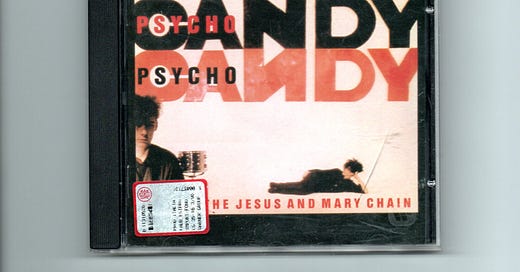There is something profoundly satisfying about reorganizing your record collection. In an era where music is often reduced to a digital file or an impersonal playlist where the song titles are sometimes unknown, vinyl records and CDs offer not only a hauntological, tangible connection to the past but also a way to celebrate art in its physical form. They invite us to listen and reassess past gems with fresh ears, bridging nostalgia and forward-looking perspectives.
During this enjoyable ritual, forgotten albums inevitably resurface, those left unplayed for years, suddenly demanding attention. Playing one of these records is like meeting an old friend: the music fills the room, evoking emotions tied to specific moments in life, while also offering an opportunity to reflect on the evolution of personal taste and passions. It’s a celebration of music’s materiality in an increasingly digital and ephemeral world and a chance to reevaluate opinions.
This time, I stumbled upon Psychocandy, the debut album by The Jesus and Mary Chain, a masterpiece that redefined the musical landscape of the 1980s by merging pop elements with a noisy, abrasive, and oppressive aesthetic. Released in November 1985, this record became a cornerstone for the shoegaze and noise pop movements, influencing countless artists and leaving an indelible mark on the history of alternative rock.
The Jesus and Mary Chain were among the most influential and innovative bands in alternative rock history. Formed in 1983 in East Kilbride, Scotland, by brothers Jim and William Reid, the band redefined rock music’s boundaries with their unique blend of pop melodies and abrasive noise. Their early career was marked by short, intensely noisy concerts that often ended in chaos and controversy. This rebellious attitude built their myth and attracted the British music scene’s attention.
In 1985, they released their debut album, Psychocandy, considered one of the most revolutionary works of the 1980s. The album combines refined pop melodies, inspired by 1960s groups like The Beach Boys and The Ronettes, with walls of feedback and distortion, creating a sonic contrast that defined their aesthetic.
The Reid brothers, the creative minds behind The Jesus and Mary Chain, envisioned Psychocandy as a sonic experiment, blending sweet, catchy melodies with production steeped in distortion, feedback, and an incessant wall of noise. This dichotomy between sweetness and chaos is the album's beating heart, simultaneously hypnotic, provocative, and almost suffocating.
Tracks like "Just Like Honey" and "You Trip Me Up" perfectly embody this aesthetic. "Just Like Honey," the album's opener, is a slow, melancholic ballad made iconic by its drum riff inspired by The Ronettes' "Be My Baby" and Jim Reid’s languid vocals. On the other hand, "Never Understand" and "In a Hole" showcase the band’s wilder, noisier side, with excessive feedback and chaotic structures reflecting a punk attitude and emotional heaviness. The electric guitars, with their raw, distorted tones, are central to shaping the album's sonic identity, crafting both the sweetest melodies and explosive noise bursts.
Another crucial element of Psychocandy is its production, overseen by the Reid brothers and John Loder. The decision to overload the tracks with layers of distortion and reverb created a distinctive sound often described as hidden beauty within chaos. This approach paved the way for bands like My Bloody Valentine and Slowdive, who would further develop the shoegaze genre.
Moreover, Psychocandy's legacy lies in how it reshaped perceptions of pop and rock music. It demonstrated that accessible, catchy songs could break traditional production and arrangement conventions. This balance between accessibility and experimentation made the album a timeless classic, redefining the image and attitude of alternative rock, making the band a symbol of a transforming era and music scene. Enigmatic, rebellious, and deliberately detached from commercial industry logic.
The interplay of heavy distortion and melody represents one of contemporary music’s most fascinating oxymorons. It is a sonic language that merges raw energy and chaos with grace and intimacy, creating a unique and captivating auditory experience. This style evokes contrasting emotions, from rage to melancholy. Distortion itself emerges from exceeding limits, an exaggerated amplification that transforms the original sound into something dense, complex, and intentionally imperfect. When this primal force is channeled into melodic structures, it creates an irresistible emotional tension.
Heavy, melodic distortion also serves as a means of personal expression. Musicians use it to translate complex and often contradictory states of mind. The melody’s linearity and accessibility connect with listeners, while distortion adds vulnerability and power. This dynamic shines in tracks that alternate between quiet moments and explosive ones, creating a tension that keeps the listener suspended between calm and chaos.
In a sense, heavy melodic distortion reflects the human condition, an intertwining of beauty and turbulence, order and disorder. Every distorted chord dissolving into a dreamy melody symbolizes struggle and reconciliation, a way to find harmony in chaos.
This is why Psychocandy by The Jesus and Mary Chain is more than just an album: it is a sonic manifesto celebrating the fusion of opposites, pop and noise, sweetness and chaos. Its sonic and emotional intensity continues to inspire and captivate, reminding us of music’s power to defy expectations and redefine the boundaries of art.





Thanks for this piece. It’s insightful and informative, and provides a useful introduction to a band I was previously unfamiliar with.